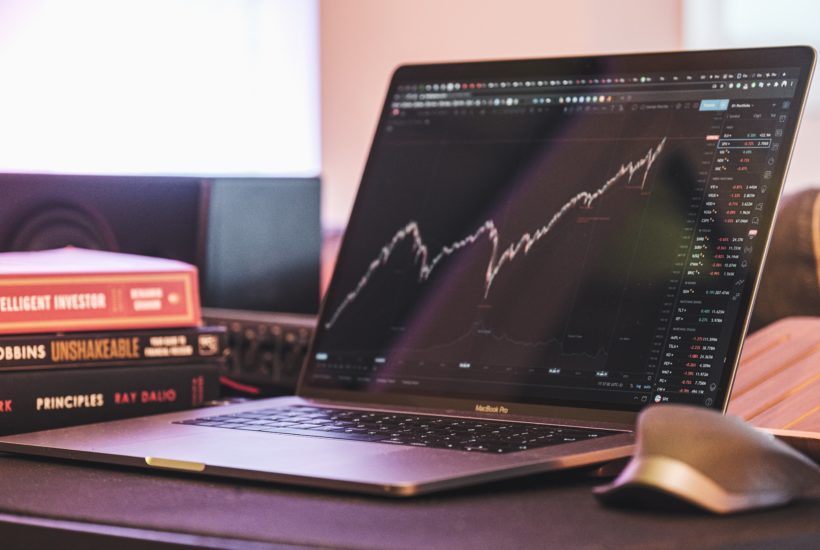Business
Are we Close to the Peak of the Fake Bull Market
The U.S. international trade deficit in goods widened 2.8% to $88.1 billion in May. The current account deficit, a broader trade measure that includes earnings on investments, widened to a 14-year high in the first quarter. What this means is that US economy is not really booming at all, it is just taking newly minted dollars and buying things that are made overseas.

We are probably very close to the peak of this ersatz bull market and economy. Peak vaccination distribution, along with the peak optimism about the vanquished pandemic and the re-opening of the economy. U.S. corporations are experiencing peak profit margins. The economy has enjoyed peak fiscal and monetary stimulus and those tailwinds will soon become strong headwinds. Also, peak tax relief is now in the rear-view mirror; and higher taxes are around the corner. Finally, peak asset valuations have arrived and the associated wealth effect is now waning.
Confirming this view is a series of slowing economic data–a reduction in the rate of change in growth and inflation. For now, this is not a crisis or a recession; but is set to become one next year. Here are some facts and data:
Personal income decreased $414.3 billion (2.0 percent) in May, according to the Bureau of Economic Analysis. Personal consumption expenditures were virtually unchanged. Despite the fact that job openings are at an all-time high, at the same time, initial jobless claims are running at a level that is 75% above/higher than the pre-pandemic level. This begs the question: why is the US laying off people at a rate that is three quarters greater than before COVID-19, despite that fact that the economy has reopened? After all, the pandemic crisis is now a year and a half old; shouldn’t layoffs be almost non-existent?
The U.S. international trade deficit in goods widened 2.8% to $88.1 billion in May. The current account deficit, a broader trade measure that includes earnings on investments, widened to a 14-year high in the first quarter. What this means is that US economy is not really booming at all, it is just taking newly minted dollars and buying things that are made overseas. What we have is peak consumption of things that aren’t made in the USA. Hence, there is not a condition of sustainable and robust GDP growth.
And, even the once-mighty housing market is starting to cool down sharply. Mortgage applications to purchase a home were 17% lower than the same week ending June 25th one year ago. The reason: home prices have risen to the highest level ever—up 14.6% y/y; and are becoming more and more unaffordable relative to incomes, while the cost to take out a loan has increased.
What all this means is that the stock market has reached a point that is in peak danger of a crash. This condition is virtually unavoidable given that the boom was completely artificial and thus unsustainable. In fact, the economy in an even more fragile state than it was prior to the pandemic. However, and this is crucial, even though chaos is coming, the timing for it to start is not at this moment. We need to be vigilant for a recession and/or credit crisis because that will be the catalyst for the 30-80% plunge to begin. This is what my 20-point IDEC model is designed to predict.
There now exists the greatest amount of margin debt on record, both in nominal terms and percentage of GDP terms. The numbers are $812 billion, which is nearly 4% of GDP. Also, passively managed funds now account for nearly half of all mutual fund and ETF assets. Up from just 14% in 2005. This means investors are just blindly piling into funds that mirror the averages. Hence, when the next bear market arrives, the market will go no bid as a result of the massive liquidations of these funds that occur simultaneously. This will force these same funds to sell the underlying securities to meet redemptions, which will in turn cause more passive holders to panic out of these funds.
Avoiding huge draw-downs in your investment portfolio is absolutely mandatory. According to NED Davis research, since 1960, the average time for the S&P 500 to recover from a 20% correction is 3 years. But a 20% correction isn’t the real risk. As already indicated, the more likely danger is a 50%+ plunge. That is how much the market would have to drop just to get back to fair value, according to the most relevant metric total market cap of equities to GDP. Hence, the greatest opportunity to make money in this market should be to short it.
The catalyst will be the same as what caused the downdrafts in 2000, 2008, 2018, & 2019: The Fed believes its own hype and begins to remove the monetary stimulus in the hope the economy has recovered. However, what the fed doesn’t understand, or refuses to acknowledge, is its massive manipulation of interest rates has caused the level of debt and asset prices to skyrocket far beyond the support of the free market, which places the economy in a much more dangerous position. Therefore, an innocuous removal of its falsified stimulus is impossible.
Bottom line: the bull market is ending because the fed is set to kill it. The process may be slow to evolve because Mr. Powell probably won’t start tapering until the end of this year. However, once the process is in full gear, the reality check should begin.
__
(Featured image by Yiorgos Ntrahas via Unsplash)
DISCLAIMER: This article was written by a third party contributor and does not reflect the opinion of Born2Invest, its management, staff or its associates. Please review our disclaimer for more information.
This article may include forward-looking statements. These forward-looking statements generally are identified by the words “believe,” “project,” “estimate,” “become,” “plan,” “will,” and similar expressions. These forward-looking statements involve known and unknown risks as well as uncertainties, including those discussed in the following cautionary statements and elsewhere in this article and on this site. Although the Company may believe that its expectations are based on reasonable assumptions, the actual results that the Company may achieve may differ materially from any forward-looking statements, which reflect the opinions of the management of the Company only as of the date hereof. Additionally, please make sure to read these important disclosures.

-

 Africa2 weeks ago
Africa2 weeks agoOil Dependence and Economic Resilience: Morocco’s Path to Sustainable Growth
-

 Africa1 week ago
Africa1 week agoBantuHub and L’Archer Group Partner to Invest €1 Million in Congolese Startups
-

 Markets2 weeks ago
Markets2 weeks ago2025 Chaos, Concentration, and the Road to 2026
-

 Business3 days ago
Business3 days agoThe TopRanked.io Weekly Digest: What’s Hot in Affiliate Marketing [Super Partners Review]












